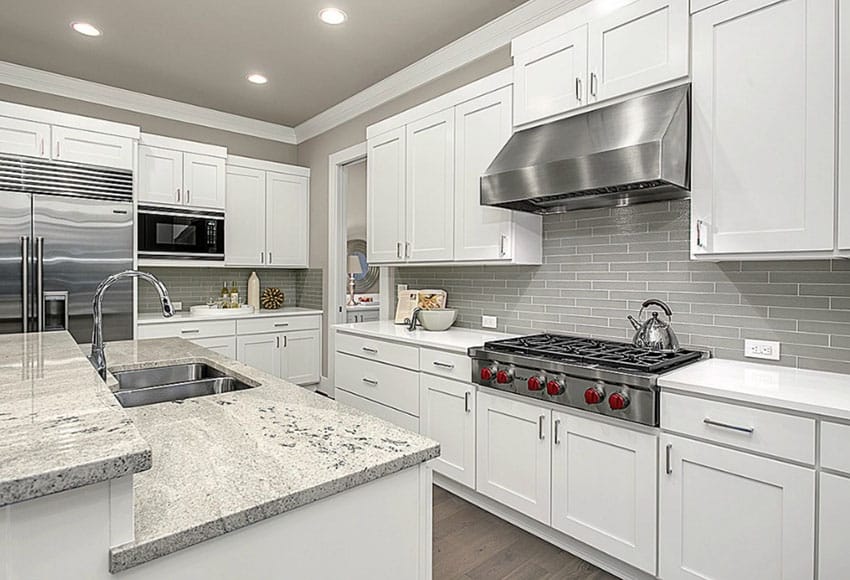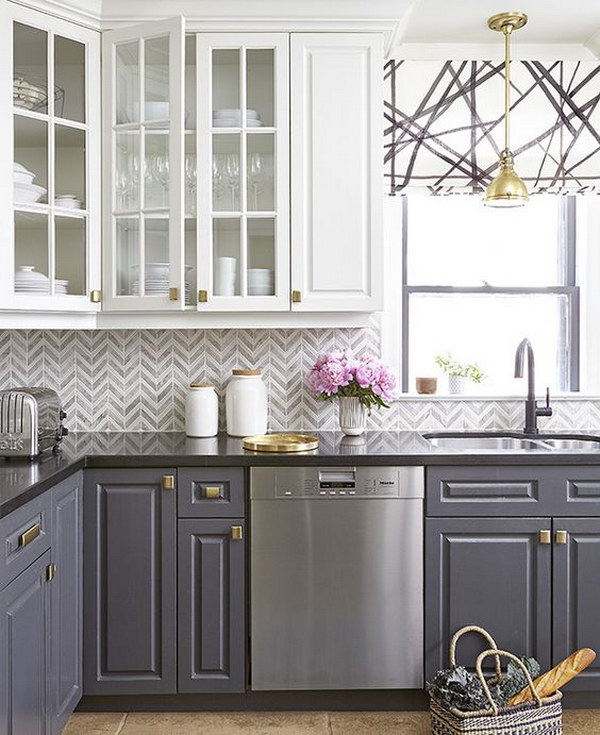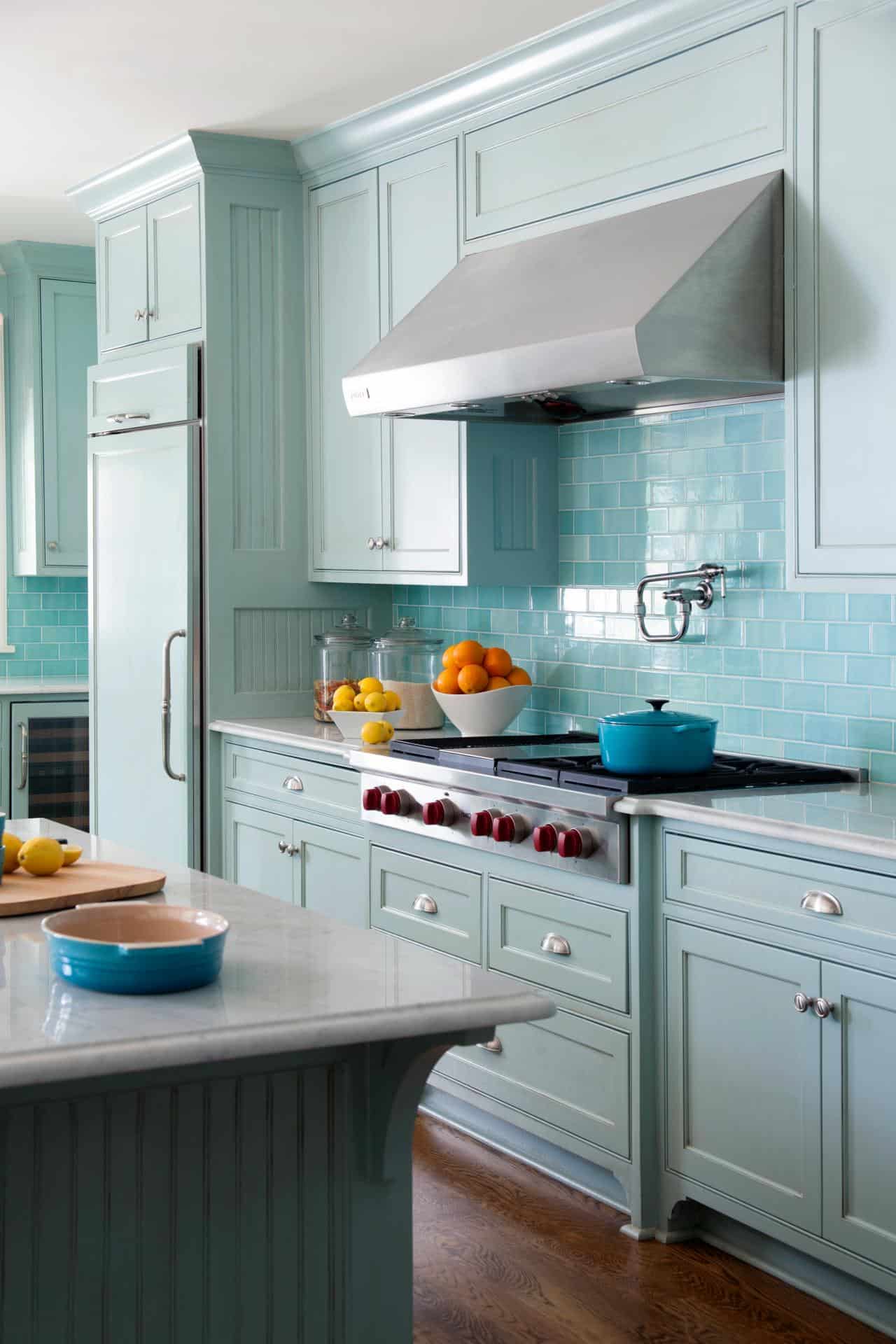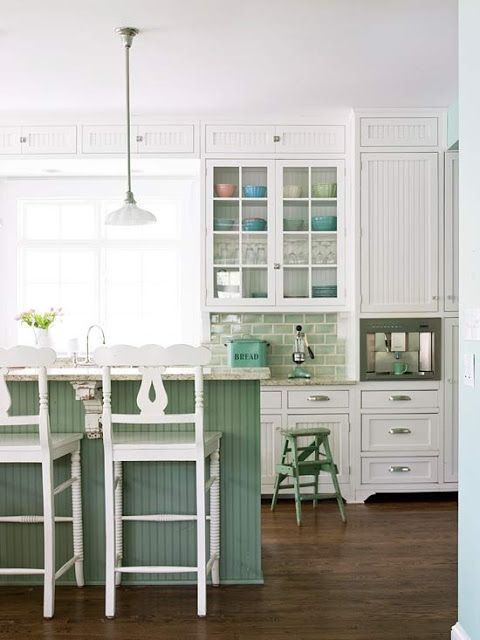Grey kitchen backsplash designs have become increasingly popular due to their versatility, elegance, and ability to complement a wide range of kitchen styles. Grey, as a neutral color, can adapt to various design aesthetics, whether modern, traditional, or transitional. When incorporating a grey backsplash into your kitchen, it’s important to consider the overall color scheme, the materials used, and the effect you want to achieve. Grey can serve as a subtle backdrop that lets other elements of the kitchen shine, or it can be the focal point that adds texture and depth to the space.
One of the first things I consider when choosing a grey backsplash is the shade of grey. Grey comes in many different tones, from light and airy to dark and dramatic. A light grey backsplash can make a kitchen feel larger and more open, especially when paired with white or light-colored cabinets. On the other hand, a dark grey backsplash can add sophistication and contrast, particularly when used with lighter cabinetry or countertops. The choice of grey can also affect the mood of the kitchen—lighter shades create a more relaxed and inviting atmosphere, while darker shades can make the space feel more formal and refined.

The material of the backsplash is another critical factor in the design process. Grey tiles are available in a variety of materials, each offering different textures and finishes. For example, grey subway tiles made of ceramic or porcelain are classic choices that can work in both contemporary and traditional kitchens. These tiles often have a glossy or matte finish, which can influence how light interacts with the space. For a more rustic or industrial look, grey stone or concrete tiles add a raw, natural element to the kitchen. These materials are often chosen for their durability and unique, organic patterns that add visual interest.
In addition to the shade and material, the size and shape of the tiles play a significant role in the overall design. Standard rectangular subway tiles are a timeless option, but for a more modern twist, you might consider using oversized tiles or smaller mosaic tiles. Hexagon or herringbone patterns can also bring a unique geometric element to the backsplash, making it a statement piece in the kitchen. I find that experimenting with different shapes and patterns can add an extra layer of creativity to the design, allowing you to personalize the space to your taste.

The texture is another element to consider when designing a grey kitchen backsplash. A textured backsplash can add depth and dimension, making the kitchen feel more dynamic. Textured tiles, such as those with a 3D pattern or a rough stone surface, can create shadows and highlights that enhance the overall look of the kitchen. However, if you prefer a more sleek and minimalist appearance, smooth, polished tiles might be a better fit. The texture you choose will depend on the style of the kitchen and the effect you want to achieve—whether it’s a cozy, rustic feel or a clean, modern look.
The grout color used with grey tiles is often overlooked but can significantly impact the final appearance of the backsplash. Matching grey grout with grey tiles creates a seamless, monochromatic look that emphasizes the tile pattern without drawing attention to the grout lines. This approach works well if you want the backsplash to blend subtly with the rest of the kitchen. However, using a contrasting grout color, such as white or black, can highlight the shape and layout of the tiles, adding definition and visual interest. I usually suggest considering the overall design and the level of contrast you want to achieve when selecting grout color.

Lighting is another crucial aspect that can affect the appearance of a grey kitchen backsplash. Under-cabinet lighting can highlight the backsplash, bringing out the color, texture, and pattern of the tiles. The type of lighting—whether it’s warm or cool—can also change how the grey tones appear. Warm lighting tends to soften the grey, giving it a more inviting look, while cool lighting can enhance the sleekness and modernity of the design. I often recommend testing out different lighting options to see how they interact with the backsplash before making a final decision.
The integration of grey backsplashes with other kitchen elements is essential for a cohesive design. Grey is a versatile color that pairs well with a wide range of other colors and materials. For example, a grey backsplash can complement white or cream-colored cabinets, creating a classic and timeless look. It can also be paired with darker cabinets for a more dramatic, contemporary feel. Additionally, grey works beautifully with natural materials like wood and stone, adding a touch of modernity without overpowering the natural warmth of these elements. When designing a kitchen with a grey backsplash, I always consider how the backsplash will interact with the countertops, cabinets, flooring, and even appliances.
One of the benefits of using grey in a backsplash is its ability to hide stains and imperfections, making it a practical choice for a busy kitchen. While white or light-colored backsplashes can show dirt and grime more easily, grey provides a bit more forgiveness, requiring less frequent cleaning to maintain its appearance. This is particularly beneficial in high-traffic areas where the backsplash may be exposed to splashes and spills. I often suggest grey backsplashes to clients who want a balance between style and practicality in their kitchen design.
In terms of design flexibility, grey backsplashes offer a wide range of possibilities. They can be used to create a monochromatic kitchen for a sleek, modern look, or they can be combined with other colors and textures to add depth and character. For instance, pairing a grey backsplash with marble countertops can create an elegant, high-end aesthetic. Alternatively, combining grey tiles with wood accents can soften the look, making the kitchen feel warmer and more inviting. I find that the versatility of grey allows for endless creativity, making it a favorite choice for both designers and homeowners.

Cost is another consideration when choosing a grey kitchen backsplash. The price can vary significantly depending on the material and complexity of the design. Ceramic and porcelain tiles are often more affordable options, while natural stone or custom tiles can be more expensive. However, investing in a high-quality backsplash can enhance the overall value of the kitchen and improve its longevity. I usually advise clients to balance their budget with their design goals, ensuring that they choose a backsplash that meets both their aesthetic preferences and practical needs.
Maintenance is an important factor to consider with any kitchen backsplash. Grey tiles, depending on the material, are generally easy to clean and maintain. Smooth surfaces can be wiped down easily with a damp cloth, while textured or natural stone tiles might require a bit more care. Sealing stone tiles can protect them from stains and moisture, making maintenance easier over time. I recommend choosing a backsplash material that fits your lifestyle and cleaning habits, ensuring that it remains beautiful and functional for years to come.
Grey kitchen backsplashes are also a great way to add a modern touch to an otherwise traditional kitchen. They can be used to update a space without requiring a full remodel. For example, replacing an old, outdated backsplash with new grey tiles can instantly refresh the look of the kitchen, bringing it up to date with current design trends. This is a relatively simple and cost-effective way to make a significant impact on the overall appearance of the space. I often suggest this approach to clients who want to modernize their kitchen without undertaking a major renovation.
Last, the choice of finish for a grey backsplash can greatly influence its overall effect. Matte finishes are popular for their subtle, understated look, which can add a contemporary feel to the kitchen. Glossy finishes, on the other hand, reflect more light and can make the space feel brighter and more open. However, glossy tiles can also show fingerprints and smudges more easily, requiring more frequent cleaning. I recommend considering how much maintenance you are willing to do and the overall look you want to achieve when selecting the finish for your backsplash.

Common Mistakes to Avoid
A common mistake when designing a grey kitchen backsplash is not considering the shade of grey to the rest of the kitchen. Grey can have warm or cool undertones, and choosing the wrong shade can clash with other elements in the kitchen, such as the cabinets or countertops.
Another mistake is not testing the tile sample in your actual kitchen lighting before making a decision. The way grey looks in natural versus artificial light can vary significantly.
Additionally, using a grout color that doesn’t complement the grey tiles can disrupt the visual harmony of the backsplash. Skipping a protective sealant on stone tiles is also a mistake, as it can lead to staining and moisture damage.
Lastly, installing a highly textured backsplash without considering its maintenance needs can result in a surface that is difficult to clean and maintain.

What materials are best for a grey kitchen backsplash?
The best materials for a grey kitchen backsplash depend on the desired look and maintenance preferences. Ceramic and porcelain tiles are popular for their durability, ease of cleaning, and variety of finishes. Natural stone, like marble or slate, offers a more organic and textured appearance but requires more maintenance, including regular sealing. Glass tiles provide a sleek, reflective surface that can brighten up the space, while concrete tiles add a more industrial, modern feel. Each material offers unique benefits, so the choice depends on the specific aesthetic and functional needs of your kitchen.
How do I choose the right shade of grey for my backsplash?
Choosing the right shade of grey for your backsplash involves considering the overall color scheme and lighting in your kitchen. Lighter shades of grey can make the space feel more open and are ideal for smaller kitchens or those with limited natural light. Darker greys add depth and contrast, making them suitable for larger kitchens or spaces with plenty of light. It’s important to test a tile sample in your kitchen under different lighting conditions to see how the shade interacts with your cabinets, countertops, and other elements.
Can a grey backsplash work with any kitchen style?
Yes, a grey backsplash can work with almost any kitchen style due to its neutral and versatile nature. In modern kitchens, grey backsplashes can enhance sleek lines and minimalist designs, especially when paired with glossy or matte finishes. In traditional kitchens, grey can add a touch of sophistication without overwhelming the classic elements. Transitional kitchens benefit from grey’s ability to bridge the gap between contemporary and traditional styles. The key is to match the shade, material, and pattern of the grey tiles with the overall design aesthetic of the kitchen.

What type of grout should I use with grey tiles?
The type of grout you use with grey tiles can either blend in or create contrast, depending on the look you want to achieve. For a seamless, monochromatic look, using a grout color that closely matches the grey tiles is ideal. This approach minimizes the visibility of grout lines and allows the tile pattern to stand out. If you prefer to highlight the tile shape or pattern, a contrasting grout color, such as white or black, can be used. It’s important to choose a high-quality grout that is stain-resistant, especially in a kitchen environment where spills are common.
How do I maintain and clean a grey kitchen backsplash?
Maintaining and cleaning a grey kitchen backsplash depends on the material. For ceramic or porcelain tiles, regular wiping with a damp cloth and a mild cleaner is usually sufficient. Natural stone tiles may require more careful cleaning and periodic resealing to protect against stains and moisture. For glass tiles, a glass cleaner can be used to keep them sparkling and free of streaks. Avoid using harsh chemicals or abrasive cleaners that can damage the tile finish. Consistent cleaning helps maintain the backsplash’s appearance and prolongs its life.
Can I mix different shades of grey in a backsplash design?
Yes, mixing different shades of grey in a backsplash design can add depth and interest to the kitchen. This approach works well in both contemporary and transitional kitchens, where a mix of tones can create a more dynamic and layered look. When mixing shades, it’s important to consider the overall balance and how the different greys will interact with other elements in the kitchen. You can use darker shades as accents or create a gradient effect by blending lighter and darker greys. This technique allows for a customized and unique backsplash design that can make your kitchen stand out.

Retro Kitchen Ideas to Upgrade Your Current Kitchen

Subway Tile Backsplash with Grey Grout

Before and after projects! (Link up your own!) from Thrifty Decor Chick

Amazing Beach-Inspired Kitchen Designs

Backsplashes Grey subway tiles, Stove and Focal points

Beautiful Kitchen Backsplash Ideas

Related Posts:
- Tumbled Stone Kitchen Backsplash
- White Hexagon Backsplash Kitchen
- Houzz Kitchen Backsplash Photos
- Fasade Kitchen Backsplash
- Modern Kitchen Glass Backsplash
- Orange Backsplash Kitchen
- How To Make Backsplash For Your Kitchen
- Can You Paint Kitchen Tile Backsplash
- Kitchen Backsplash Subway Tile With Accent
- Backsplash Tiles For Kitchen Ideas Pictures